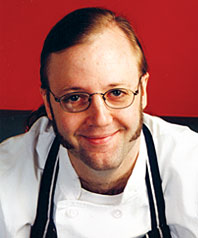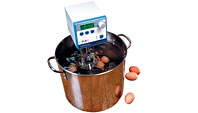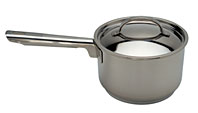
No longer the province of greasy spoons and Sunday brunches, eggs have become a culinary obsession of late, splattered on menus in such cholesterol-spiking profusion it’s a wonder Tom Frieden hasn’t banned them yet. It’s not just the luxurious texture and low cost that appeal to chefs, or the increasing availability of ultra-fresh, heritage-breed eggs at farmers’ markets. There’s also their affinity for immersion circulators, temperature-controlled water baths that have changed the face of modern cookery, affording gadget geeks an enticing new precision and giving “slow-poached” a whole new meaning. For a poaching primer, we turn to egg lover and gadget enthusiast Wylie Dufresne, whose obsession began, as so many do, in childhood. “My mother made the best scrambled eggs, super-loose and soft,” he remembers. From there, it was a slippery slope. “Hollandaise, I would like to pour over my head and just rub all over myself. Eggs Benedict is genius. It’s eggs covered in eggs. I mean, come on, that person should be the president.”
When Dufresne opened wd-50 four years ago, he began experimenting with circulators, which have aided him in his quest for the perfect poached-egg texture. For him, that’s the elusive point at which the white is “like junket” and the yellow approximates “egg-yolk fudge.” That fudge—a state somewhere between liquid and solid, attained in a 64 degrees Celsius water bath after 55 minutes, give or take ten minutes or so—can be seen in all its vivid glory in Oeuf, Lyndsay and Patrick Mikanowski’s gorgeous new coffee-table cookbook, which features a recipe from Dufresne. And it can be tasted in Dufresne’s slow-poached egg, plated at wd-50 with a swipe of chorizo emulsion, dried black olives, and pickled beets. But despite the personal pyrotechnics, Dufresne still appreciates a good diner omelet, like the one at Joe Jr., the Third Avenue coffee shop he’s patronized since ninth grade. And though he’s more apt to scramble at home, “I think I can poach a pretty mean egg the old-fashioned way.” Below, he tells you how. If you’re intent on slow-poaching like a pro, of course, you can always invest in an immersion circulator of your own. Dufresne is partial to the “very simple, very powerful” PolyScience model No. 7306, which will run you $950 at J. B. Prince.
How to Cook an Egg, By Wylie Dufresne

High-Tech
“Let eggs sit out at room temperature for a couple hours so they won’t crack when they hit the water. Put them in a 64-degree bath, bring them back up and hold them there. After about 55–60 minutes, crack one open to check the texture. When they’re right, remove them and put them in an ice bath to cool. It’s nice to do them the day before you serve them and refrigerate them overnight, because as they cool they sort of set in the shell in a beautiful ovoid shape. Reheat by soaking them in 145-degree water for five minutes, then crack them into a bowl.”

Low-Tech
“Crack your eggs into a little ramekin. Bring a saucepan of water, with a little vinegar to help the proteins coagulate, to a boil, and then turn it off. Take a big spoon and stir the water vigorously in a circular motion, ten times or so, to really get it moving. Get the ramekin as close to the water as you can, and quickly slide the egg right into the center of the whirlpool. The motion of the water will cause the egg to wrap around itself, and you’ll get a really nice shape, and the watery bit of the white will break off and float to the top where you can skim it off. After about three and a half to four minutes, scoop out your eggs and put them onto lightly toasted and well-buttered English muffins, aggressively topped with hollandaise and chopped chives, with some bacon on the side. Potatoes are optional.”